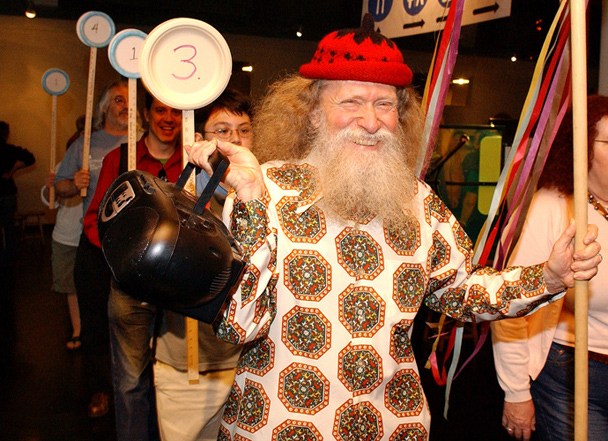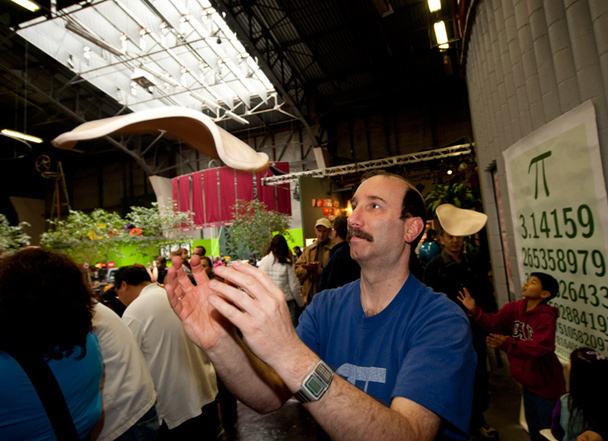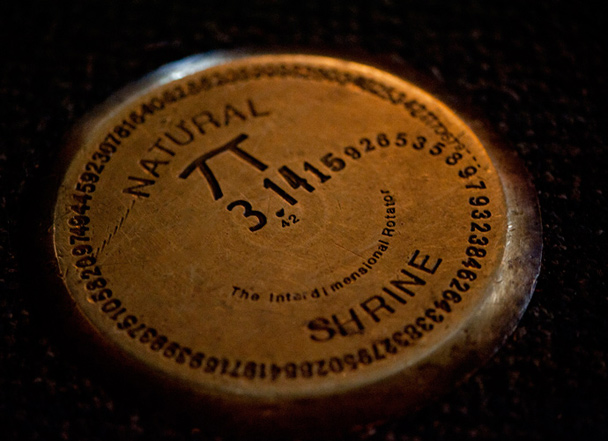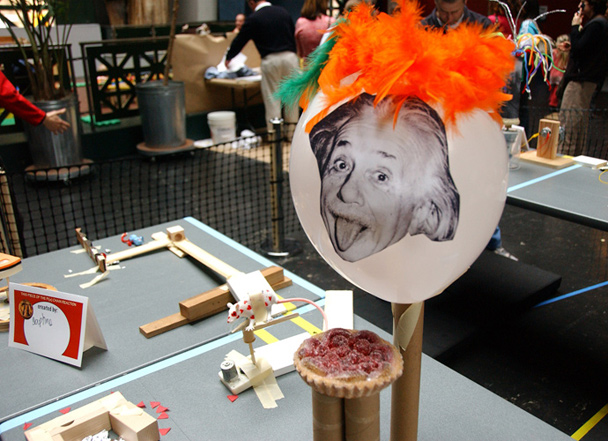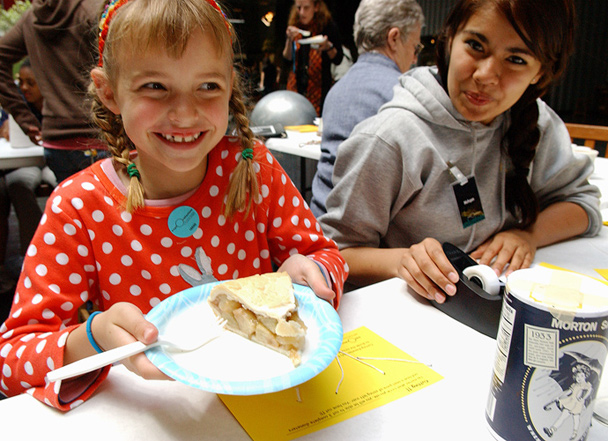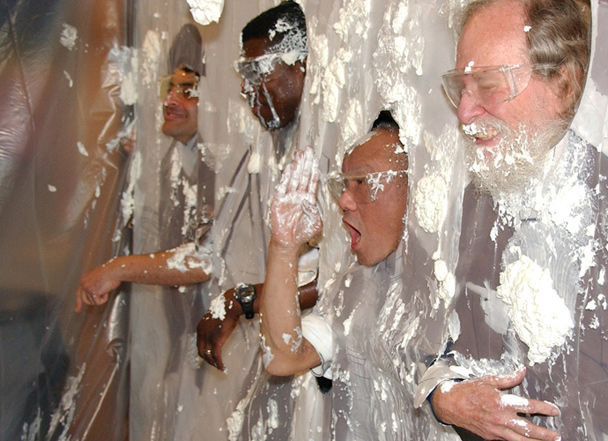Tap picture to advance the slideshow.
What does March 14 mean to you? If you’re physicist Larry Shaw and fortunate enough to have a day job at San Francisco’s Exploratorium, it’s a great excuse for a very big party. And if you’re mathematically inclined, you may recognize, as Shaw did decades ago, a correspondence between the date and 3.14, the iconic number otherwise known as π, or pi.
Considered both “irrational” (because its decimal expansion is infinite and nonrepeating) and “transcendental” (because it cannot be produced by a finite series of calculations), pi has inspired celebrations in a similar spirit since 1988, when Shaw hatched the Exploratorium’s first Pi Day. In more recent years, the “holiday” has gone global and in 2009 received official recognition from Congress. Being a bit irrational and transcendental ourselves, we couldn’t resist investigating the backstory of this tradition and, of course, its links to the homophone pie. Answers came from Shaw, a.k.a. the Prince of Pi, now retired; his fellow physicist and Pi Day coconspirator Ron Hipschman; and Melissa Alexander, director of public programs at the Exploratorium.
Gourmet Live: How would you define pi for food lovers?
Ron Hipschman: Pi is defined by the ratio of a circle’s circumference to its diameter. In other words, if you stretch a string around a can of soup, the string will stretch across the diameter of the can a little more than 3 times (3.14159…, or pi, times, to be precise).
GL: Pi dates back some 4,000 years, yet it was not until 1988 that Pi Day was created. What inspired this?
Larry Shaw: The original impulse came from an evening-long conversation in 1983, with a brilliant musician/mathematician friend, Jim Horton. We thought that the mysterious irrationality of pi should be celebrated by some place, to experience and contemplate this multidimensional mystery. A “shrine” to pi! This became a real project with members of the staff of the Exploratorium after the first all-staff retreat in 1988. The Brass Pi Shrine is the outcome, and we celebrated the first Pi Day on March 14, 1988.
GL:What form does the Pi Shrine take?
Melissa Alexander: The Pi Shrine—a round, small bronze plaque embedded in the floor of the Exploratorium’s mezzanine level—appears rather prosaic at first glance. Most of the time it goes unnoticed by our visitors, who walk right over it.
Nonetheless, it is key to a winsome and rather wonderfully inclusive and absurd ritual that is inherent to our museum community—which includes, by the way, both ourselves and our visitors who help perform it.
GL: How did Albert Einstein’s birth date—also March 14—play into the creation of Pi Day?
LS: It didn’t. We didn’t know until my daughter Sara Shaw was doing a school report on Einstein, and she said “Hey, Dad, Pi Day is Einstein’s Birthday!” The connection enhances the dimensions of the celebration. As it says on the Pi Shrine “Pi: The Interdimensional Rotator.”
GL: How does the Exploratorium typically celebrate Pi Day?
RH: We have pi talks and demos. We’ve had Albert Einstein (in puppet form) doing a rap about pi. We’ve had pie tossing and pizza dough tossing. We’ve had a chain reaction using objects related to pi. To start Pi Day celebrations, Larry Shaw leads a “Pi Procession” with each person in the line carrying an appropriate digit of pi. They march through the museum and up onto our mezzanine where, in the middle of the circular library building (made of circular cinder blocks), they circumambulate the Pi Shrine 3.14 times while singing “Happy Birthday” to Albert Einstein. We also add colored beads—each color signifying a digit from zero to nine—to a “Pi String.” The accuracy of the Pi String grows with each successive Pi Day.
GL: We understand that reciting the decimal places of pi is another annual tradition. How many digits have you memorized, and what’s the world record?
RH: Thirteen—more than enough for any calculation. According to Wikipedia, “the Guinness-recognized record for remembered digits of π is 67,890 digits, held by Lu Chao, a 24-year-old graduate student from China. It took him 24 hours and 4 minutes to recite to the 67,890th decimal place of π without an error.”
GL: It wouldn’t be a party without something good to eat. What does the museum serve on Pi Day?
RH: Any and all appropriate pi-related foods. That could mean anything from food that is round to food that sounds like pi—like pie! In the past, we have usually had sweet pies—apple, berry, lemon meringue—and we’ve had pizza pies. This year we are mixing it up by inviting Peasant Pies of San Francisco to serve some delicious savory pies. The staff used to make their own pies to bring in. That was a favorite version of the tradition—it has such a great sense of community. And who can argue with homemade pie?
GL: By contrast, what’s the weirdest Pi Day experience you can remember?
RH: Well, the whole thing is pretty strange, really. It’s just a great opportunity to talk about math and where you see it in nature. Having said that, it’s always fun to see how enthusiastic people are about this special transcendental number. We get people dressing up for it, wearing their favorite pi T-shirt, jewelry they’ve made. We even have one set of parents who named their son Pi and bring him every year. How cool is that?
GL: What do you think of Pie Day, January 23, founded in 1986 by the American Pie Council?
LS: Great idea! I didn’t know anything about it until tonight. I suspect others might have known but might have “failed” to tell me.…A good pie is always a celebration!
GL: This year’s Pi Day is the last to be held in the longtime home of the Exploratorium, San Francisco’s Palace of Fine Arts. What can you tell us about the museum’s new location and any special pi-related observances the move will entail?
MA: This year, after [Pi Day], we intend to remove the Pi Shrine from its home of many years and pack it safely in a velvet-lined pie tin for safekeeping. In a way, the removal of our shrine signals the beginning of our physical good-bye…and hello to our spectacular new site at Pier 15. One of our first acts in our new home, even before we open, will be to christen our new space with the ritual of our pi celebrations and to place the Pi Shrine in our new, free public space. The ridiculous and wonderful Pi Day ceremony will happen at Pier 15 in 2013. Like many cultures and immigrants, we take our traditions with us to our new world.

